I design apartments since 2008 and landed houses since 2010. “Teoalida’s Virtual City” with my own building codes for standard housing, luxury housing, low-cost housing, Hong Kong and Philippines housing. The rules written on this page apply for projects I designed from personal interest. When I design for customers, I follow laws of their countries.
The below table shows comparison between my virtual city building code and real countries building codes (most countries regulate room minimum width and minimum area).
| Room | Teoalida’s Housing | Singapore | Malaysia | South Korea | India | Philippines | Brazil | |
|---|---|---|---|---|---|---|---|---|
| Low-cost | Standard | |||||||
| Living room | 2.9 m 16 sqm | 3.4 m 20 sqm | – | 2.0 m 11 sqm | usually 3.6×3.6 m | – | – | 2.4 m 8 sqm |
| Kitchen | 1.9 m 6 sqm | 2.4 m 8 sqm | – | 1.5 m 4.5 sqm | – | 1.8 m 5 sqm | 1.5 m 3 sqm | 1.5 m 4 sqm |
| Master bedroom | 2.9 m 11 sqm | 3.4 m 14 sqm | – | 2.0 m 9.3 sqm | usually 3.6×3.6 m | 2.4 m 9.5 sqm | 2 m 6 sqm | 2.4 m 8 sqm |
| Other bedrooms | 2.4 m 8 sqm | 2.9 m 11 sqm | – | 2.0 m 6.5 sqm | usually 2.7×3.6 m | 2.1m 7.5 sqm | 2 m 6 sqm | 2.4 m 6 sqm |
| Bath | 1.2 m 3 sqm | 1.5 m 4 sqm | – | 0.75 m 2.0 sqm | usually 1.8×2.4 m | 1.2 m 2.8 sqm * | 0.9 m 1.2sqm | 1.2 m ? Sqm |
| Toilet | 1.2 m 1.8 sqm | 1.5 m 2.5 sqm | – | 0.75 m 1.5 sqm | usually 1.5×1.8 m | 0.9 m 1.1 sqm | – | – |
| Washing room | – | – | – | – | – | – | – | 1.2 m 2.4 sqm |
| Store room | – | – | – | – | – | 3 sqm | – | – |
| Ceiling height | 2.6 m | 2.8 m | 2.6 m | 2.5 m | probably 2.7 m | 2.75 m | 2.4 m * | 2.4 m |
| Hallway public | 1.5 m | 1.5 m | 1.5 m | ? | usually 1.5 m | 1.5 m ? | ? | 1.2 m |
| Hallway private | 0.9 m | 1.2 m | 1 m | ? | usually 1.5 m | 1.2 m | 0.9 m | 0.8 m |
| Staircase public | 1.4 m | 1.4 m | 1 m | ? | usually 1.2 m | 1.5 m ? | ? | 1.1 m |
| Staircase private | 0.9 m | 1 m | 1 m | ? | ? | 1 m | 0.75 m | 0.8 m |
Sources and full building codes:
Singapore: www.bca.gov.sg
Malaysia: https://www.scribd.com/doc/30457115/13282147-Uniform-Building-by-Laws
Philippines: http://www.chanrobles.com/republicactno6541.htm
Indonesia: https://leumburkuring.files.wordpress.com/2012/05/sni-03-1733-2004-tata-cara-perencanaan-lingkungan.pdf and http://jdih.pu.go.id/peraturan-download.html?id=1935
India: http://www.slideshare.net/SivaSankar8/national-building-code-2005
Brazil: do a Google search “codigo de obras“, they have different building code for each state.
South Africa: http://sans10400.co.za/
Nigeria: http://sdngnet.com/Files/Lectures/FUTA-ARC-807-Professional_Practice_and_Procedure/CD%202013-2014/National%20Building%20Code%20of%20Nigeria%202006.pdf
United Kingdom with comparison with the rest of Europe: http://www.hatc.co.uk/wp-content/uploads/GLA_Space_Standards_Report.pdf
If you have / found building codes for more countries, please send me (link to website, or email me if is .DOC or .PDF) so I can add in above list.
* Notes:
Brazil: each state have own laws, in some states, the laws are minimum 2.5 or 2.8 m / 10 sqm for living room, 9 sqm for master bedroom, 7 sqm for other bedroom.
India: bathroom without WC 1.2 m / 1.8 sqm, bathroom with WC 1.2 m / 2.8 sqm.
Philippines: the law says 2.7 m ceiling height for ground floor, but most homes are built with 2.4 m ceiling for all floors.
South Korea: I never saw building code. But I love their apartments and I studied a lot, the “usually” dimensions are taken from floor plans of 4-room and bigger apartments, there are a small number of apartments having rooms smaller than usual sizes.
The concept of Teoalida’s Housing
I started designing buildings in 2008, “Teoalida’s Virtual City”, originally a hobby of graphic design and 3D modeling in AutoCAD, but a fully functional housing system (virtual city – because I do not have capital to build what I design). Dozens apartment block models, constantly improved, imagining being president of a country or manager of a housing corporation, with mission to offer quality housing for at least half of population, like what does HDB in Singapore (I am fascinated especially by public housing around the world).
I studied many public and private developments around the world, and also aftermarket renovations, to determine “ideal housing” that will suit most customers in the world.
My original concept in 2008-2010 was to make cities with average apartment size of 100 sqm, average household size of 3.4 people, one room per person, 30 sqm per person. Ideal distribution: 10% of 50 sqm 2-Room, 30% of 80 sqm 3-Room, 40% of 110 sqm 4-Room, 20% of 140 sqm 5-Room, resulting average size of 101 sqm.
Currently I design apartments for minimum 20 sqm per person thinking that the real sqm per person will vary a lot due to income and living style (I reminded how I spent childhood in a block with 2/3-room apartments and I had neighborhoods living alone in 3-room but also families of 6 people in 2-room).
For comparison, developed countries of Europe and Japan have an average of 35-40 sqm per person but this is due to average household size of only 2.1-2.5 people, probably due to people owning multiple properties such as city apartment and country house, and rent them to singles. Inside cities the average is probably under 30 sqm per person. Singapore household size is 3.5 and Malaysia 4.3.
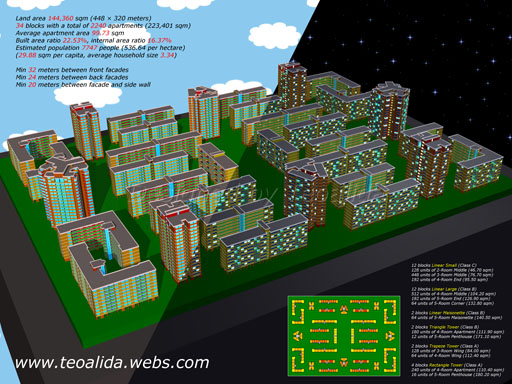
Floor plan drawing styles
1. Wall axis and binary metric dimensions: I make wall axis at integer number of meters or half, then offset wall face 1/16 meters, and external wall with 1/4 meters, thus most room dimensions x375 or x875 mm and overall building dimension x500 mm (used since 2008 to 2013 for projects designed for hobby / artistic).
2. Wall axis and decimal metric dimensions: I make wall axis at integer number of meters or half, then offset wall face 5 cm, thus most room dimensions are x400 or x900 mm and external building dimension x300 mm or x500 mm (planned in 2012 to replace binary metric system).
3. No wall axis and metric / imperial dimensions: I make exterior of building at a integer number of meters, then most important rooms dimensions in integer meters, internal walls 10, 15, 20 cm and external walls 20 cm (used first time in 2011 for Hong Kong-inspired apartments designed from personal interest and since 2012 for landed houses designed for customers).
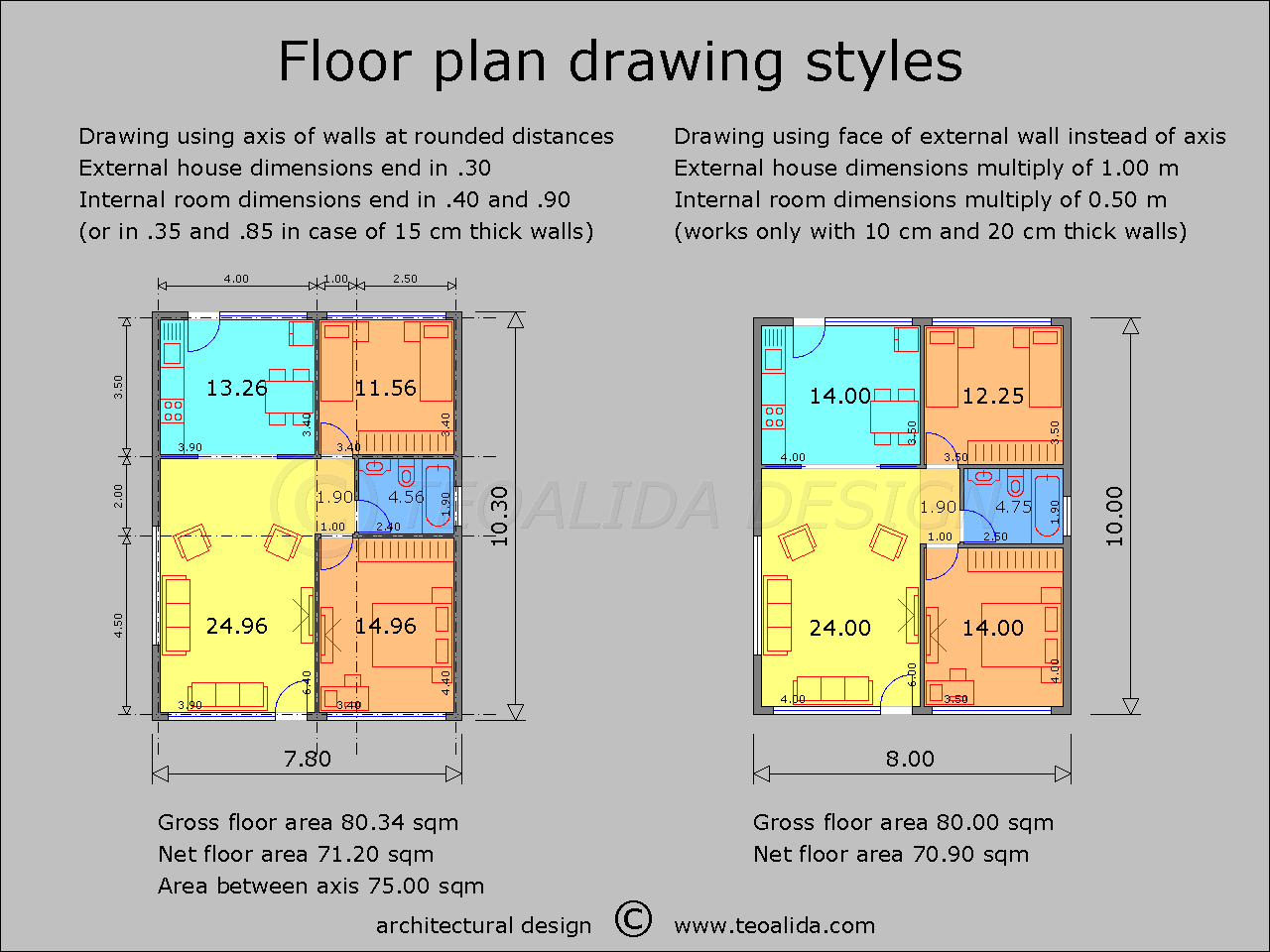
Guidelines in Teoalida’s housing (OLD rules used in 2008-2011)
First designs I made in 2008 were based on 4-meter grid. In 2009 I defined 3 classes mostly based on bedroom size: class A 4 x 4 m bedrooms, class B 3 x 4.5-5 m bedrooms, class C 3 x 4 m bedrooms. Living room was minimum 4 meters wide. Bathrooms were 2 x 2.5 m or 2 x 3 m and included bathtbub. Starting from 3-room apartments, 2 bathrooms were provided. In case of 3-room the common bathroom could be 2 x 2m with shower only.
The apartments must be square-ish as possible, with all rooms arranged around a central point, I try to minimize comfort problems like couch-TV placed in the passing zone. The hallways area must be reduced to minimum possible, some apartments uses the dining area as hallway, to create smallest apartments without affecting room spaciousness.
Typical apartment net floor area (excluding balconies or walls):
2-Room: C 45 sqm, B 50 sqm, A 55 sqm
3-Room: C 72 sqm, B 78 sqm, A 87 sqm
4-Room: C 96 sqm, B 104 sqm, A 116 sqm
5-Room: C 120 sqm, B 130 sqm, A 145 sqm
Guidelines in Teoalida’s housing (NEW rules used since 2012)
Further study of various countries revealed that apartments were oversized compared with most countries standards. Since 2011 I did not made new “class A”w designs with 4×4 meter bedrooms, 3×4 meter became most common size so I defined new guidelines.
Guidelines for standard housing
An ideal city should regulate both minimum room sizes and minimum apartment size, not just individual room sizes. By this way developers have some freedom to make some apartments with bigger living room and other apartments with bigger bedrooms, to make all rooms accessible from living room, or to add hallways.
Minimum net floor area (excluding walls and balconies):
1-bedroom 1-bath = 40 sqm
2-bedroom 1-bath = 60 sqm
2-bedroom 2-bath = 70 sqm
3-bedroom 2-bath = 90 sqm
4-bedroom 2-bath = 120 sqm
For comparison, the apartments currently built by HDB in Singapore have gross floor area 3-room 65 sqm and 4-room 90 sqm, but these include wall thickness too, as well as an useless “household shelter”, so the internal size is about 10-15% lower, making them unlivable in my opinion. The HDB apartments built in 1980s and 1990s are slightly above the minimal floor area in my ideal city.
The following regulations were intended for the system with wall axis and 10 cm walls.
Living room: minimum width 3.4 m, 2.9 m wide is allowed for 2-room. Recommended size for living + dining: 18 sqm for 2-room, 20 sqm for 3-room, 25 sqm for 4-room, 30 sqm for 5-room.
Dining room: 3-room apartments should provide space for dining table for 4 people while 4-room apartments should provide space for a dining table for 6 people, if it is a separate room, its size should be at least 3 x 3 m. In low-cost apartments people can eat in front of TV on a folding table with folding chairs.
Bedrooms: recommended size 2.9 x 3.9 m or 3.4 x 3.4 m (11 sqm). This size easily accommodate a wardrobe and one double bed or two single beds (or wardrobe, bed, desk).
Master bedroom: for 3-room apartments, one bedroom is recommended to be 2.9 x 4.9 m or 3.5 x 3.9 m (13 sqm) and for 4-room and bigger 3.4 x 4.9 m (16 sqm). Bigger apartment means richer owner so need a bigger room.
Kitchen: minimum 2.4 m for cabinets on both sides, minimum 8 sqm for 3/4-room, 10 sqm for 5-room. 2-room can have kitchen 1.9m wide with cabinets on one side and 6 sqm.
Most f my designs use enclosed kitchen but placed in a way that allow hacking wall to living room for people who love open-concept kitchen.
Bathrooms: recommended size 2.4×1.6 m to fit toilet bowl, sink and bathtub, or 2.4 x 1.4 m with shower, or 1.9 x 1.9 with corner shower. Typical bathtub size is 150-160 cm long and 75-80 cm wide (60 x 30 in).
Hallways: most of my designs use 1.20 m width hallways to comply with almost every country’s building code. Together with bathroom width of 1.60 m and two walls 10 cm thick, makes a rounded value of 3 meters.
Staircases: minimal width 90 cm, recommended width 1 m.
Guidelines for luxury housing
I define as luxury the projects that include en-suite bathroom for every bedroom and private lifts. Minimum room dimensions are the same like standard houses, but there are no maximum limits. See Singapore & Malaysia 3-storey houses where smallest bedrooms are 19 sqm.
Guidelines for low-cost housing
Beside the “standard size” housing, I also made low-cost designs inspired from Latin America where for example in Brazil (each state have own laws about minimum room sizes) I saw that most apartments have master bedroom 2.6 x 3.2 m, common bedrooms 2.4 x 3.2 m (judging by bed size 80×200 cm and wardrobe 50 cm deep, a 2.4 x 3.2 m bedroom allow 70-80 cm clearance between furniture), bathrooms 1.2 x 2.2 m or 1.5 x 1.5 m with corner shower. Living room can be as small like a bedroom.
My low-cost housing designs have all rooms dimensions rounded to 50 cm, making floor plans nice also from artistic point of view. Wall thickness is again 10 cm.
Living room: minimum 3 meters width, floor area vary depending by number of rooms.
Bedrooms: minimum 2.4 x 3.4 m, this is the minimum size that fit 2 single beds or 1 single bed and desk, and a wardrobe.
Bathrooms: minimum 1.4 x 2.4 m.
Hallways and staircases: minimum 90 cm wide.
Apartment net floor areas: around 45 sqm for 3-room and 60 sqm for 4-room.
Guidelines for Hong Kong-inspired designs
Due to limited build-able land and high population density, Hong Kong built the smallest apartments in the world, with bedrooms 2 x 2 m just to fit a single or bunk bed. Apartments commonly have 2 and 3 bedrooms.
My Hong Kong-inspired designs I tried to make bedrooms 2 x 2.5 m, living room min 2.5 m wide, in kitchen 1.5m wide (50 cm cabinets + 100 cm space, in Hong-Kong all kitchens are enclosed), bathroom 2 x 1.5 m wide because is popular in Hong Kong to have bathtub instead of shower.
Guidelines for the houses I designed for Philippines
Philippines is the country I had most paying customers as architectural designer. Because of poverty and culture, most filipinos live in small houses with a minimum of furniture, most houses have 2 bedrooms and most apartments being studio and 1-room.
Their building code is one of most permissive in the world, allowing bedrooms small as 6 sqm (but I saw many buildings with even smaller bedrooms) and my projects for Philippines are designed accordingly: bedroom minimum 2 x 3 m or 2.4 x 2.5 m and 6 sqm, living room minimum 2.5 m wide and 10 sqm (building code do not specify size for living room, it can be same size like a bedroom, but isn’t logical to be bigger?), bathroom 1.2 x 2 m (building code allow bathroom narrow as 0.9 m, leaving just 20 cm between front of toilet bowl and wall, using toilet is difficult). 90% of houses built in Philippines use open kitchen.
Other guidelines
Minimum ceiling height is 2.4 m in Philippines, 2.44 m (96 in) in United Kingdom, 2.6 m in Singapore, 2.7 m in India, etc.
My projects are designed with floor-to-floor height of 3 meters for being a round number, make designs simpler and improve aesthetic proportions. With standard 20 cm floor slab, ceiling height would be 2.8 meters. Luxury houses have taller ceiling. Houses I designed for Philippines use 2.6 meters floor to floor (2.4 meter ceiling).
Stairs: US building codes usually say that 2x riser + thread to be around 600-650 mm. (source: Wikipedia). My early projects had oversized stairs. Since 2010 I use stairs with 5/16 m (31.25 cm) tread and 1/6 m (16.67 cm) riser, 18 steps per floor, pitch of 28%. In 2013 I defined new rules:
Apartment designs use 300 mm tread and 167 mm riser = 634 mm according above formula, pitch 29%, 3000 mm floor-to-floor, 18 steps.
House designs use 250 mm tread and 200 mm riser = 650 mm according above formula, pitch 39%, floor height 2600 mm (13 steps) to 3000 mm (15 steps).
Balcony parapet and stair guardrails minimum height vary between 90 and 105 cm tall depending by country. Someone asked me what is minimum height for window sill. There is NO such rule, windows can start from floor (full-height window) but must have NO opening panels below 90-105 cm height, or have a non-removable guardrail at panels that open.
Windows: most of my designs use windows that are 150 cm tall and start at 100 cm from floor, so piece of wall separating windows have same height with windows. Philippines designs use 120 cm tall windows at 90 cm from floor.
Doors: in some countries in Europe, at least in communist times, doors width was 80 cm for main rooms, 70 cm for kitchen, 60 cm for bathrooms. In Singapore all doors were 80 cm wide until ~2000 when they decided to make 90 cm wide to facilitate wheelchair users.
My projects are designed with 80 cm wide doors except Philippines ones where bathroom doors is narrower.
Guidelines for car parks
Street parking: an international recommendation is to have 80 cm space between cars. Most open parking lots are designed 2.5 m wide because cars were traditionally 1.6-1.7 m wide. This is getting a problem as since 1990s cars are getting fatter, today most of cars being over 1.8 m wide. American parking lots are 2.7-3.0 m wide because their full-size cars were up to 80 inch (203 cm) wide during 1970s, in Japan and Brazil I saw 2.2-2.3 m wide parking lots.
Basement parking: perpendicular lots should be wider if there are columns around, clearance between columns should be at least 3 meters to allow space to steer.
Public parking lots should be 5 meters length.
Private garages and carport size should be based on what car you own or intend to own in the future, usually minimum 2.9 m width and 5-6 m long. A house is designed to last at least 50 years, you should make provision for bigger future cars. Take a look how much cars grown past 50 years: Car Length Evolution.
Note: Philippines building code do not specify minimum size for private carparks, thus developers follow the rule of street parking (2.5 x 5 m), which makes carport unusable because if you park an 1.8m wide car in a 2.5m wide space between walls you cannot get out of car (unless is a convertible).
Outside United States and Canada, 90% of cars are up to 5 meters length. Europe is dominated by cars 4-5 meters long, but Asia, Africa and Latin America are dominated by smaller cars.
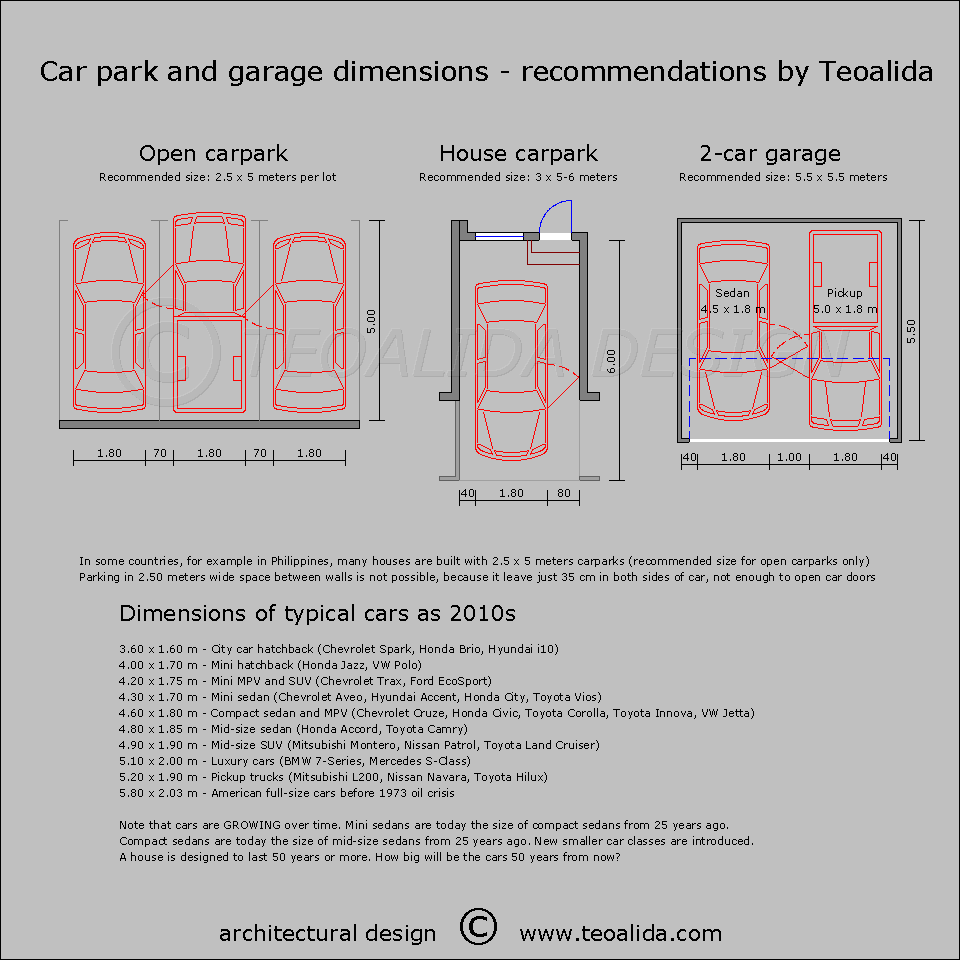
Efficient town planning for high density
Most cities regulate building density on each plot of land using maximum height and maximum plot ratio (gross floor area divided by land area). If I were a real estate developer I will try to make buildings as long and wide is possible to increase distance between building facades.
I made a perimeter around block that is 16 meters in front of any wall containing living rooms and bedrooms (12 meters in case of side walls having maximum 1 bedroom window) and 4 meters in front of walls having no bedroom windows, and tried to arrange various block models in a neighborhood without overlapping perimeters to see which models have highest land coverage.
I usually design 3D models in 8 and 16 storey heights, most designs can be built taller, given by number of lifts in floor plan.
Inspired from public housing designs across Europe and Singapore built up to 1990, my early city planning concepts had tower blocks max 25% of total number of blocks. This is no longer common nowadays, most developers make all blocks same height or a small variation of height between blocks or even parts of same block (see Bishan estate in Singapore).
According these rules, a typical housing estate, will have 140-160 apartments per hectare, building coverage about 20%.
European-communist style, long segmented blocks with 4 units per staircase, having windows on 2 facades, is efficient only for small, 2-room apartments, for larger ones will create too long apartments with space-wasting hallways and bathrooms will have no ventilation.
Corridor-style blocks common in East Asia, with a single row of apartments, are efficient for small and middle size apartments and allow cross-ventilation. Their width is usually 12-14 meters. This design suffer from low efficiency in terms of having large common areas vs total gross floor area, but this can be improved by making blocks U-shaped or circular (example).
Staircase-style blocks with only 2 units per floor, are also efficient but only for big apartments (over 100 sqm). Their width is 10-12 meters.
Tower (point) blocks with 4 to 8 units per floor and windows on all facades add some beauty to the city skyline, but land coverage will be 20-30% lower.
I can achieve a higher density with a small compromise of ventilation by moving kitchens to inside of block, ventilated through airwells, 4 apartments per staircase and build segmented blocks in zig-zag to open airwells (example).
Parking: some countries regulate that 1 or 2 parking lots should be provided for each apartment. This is inefficient, because residents of large apartments tend to own more cars. The best law is to provide a parking lot for every # square meters of residential space. Exact sqm # figure vary from city to city (expect lower car ownership ratio in cities with good public transport).
In case of an estate with 8-storey blocks, the space between buildings provide about 1 parking lot per 100 sqm of residential area. Singapore started building multi-storey car parks (usually 5 floors) in every estate since 1990 but this is a bit inconvenient because you go down with lift then go upstairs in the parking to your car (only in 2006 they started to retrofit car parks with lifts) and car headlights flood rooms of unlucky residents.
I saw across Europe and Latin America underground car parks that extend only under actual building, this is not efficient because you need to go multiple floors underground and is prone to flooding.
The ideal solution in my opinion is to have a basement car park under entire estate, not only under buildings (which can be at ground level, not necessary to be underground) and cover it with a roof with greenery so residents will only see greenery from their apartments and not car headlights disturbing their sleep.
Efficient landed housing layout for high density
When I started designing landed houses in 2010, my first designs were inspired from Singapore where houses prices are over 1 million dollars so only rich people own houses, thus my designs were luxurious, narrow (terraced and semi-detached) but deep and tall (2-4 storey), having gross floor area bigger than land area. I hated single-storey houses because are a waste of land. Only in 2012 I started designing detached houses and single-storey houses.
In most cities from the world, the houses are built close each other, since you have few neighbors is not necessary to keep distance. Japan detached houses are usually 30-50 houses per hectare (Japan residential roads width is 4-5 meters, sidewalks are nonexistent, and houses can be 50 cm each other, usually 2 meters. Singapore and Malaysia terraced houses are 50-60 dwellings per hectare. Except United States, Canada, Australia, New Zealand and some parts of Europe where density is 10-15 houses per hectare.
In an ideal city, my rules would be like this:
Setbacks: front 6 m (will allow space for parking a car), back 4 m, sides 2 m. Developers will be encouraged to put the important rooms facing front and back.
Minimal lot width: terraced 6 m, corner-terrace and semi-detached 8 m, detached 12 m.
Minimal lot depth: 20 m, so the houses will be minimum 10 m deep. I recommend 24 mdeep, if you think that is not possible houses so deep without having windows to sides, take a look in House Plans as I have designed terraced houses 14-16 m deep.
By considering that streets are 12 m wide (6 m road plus sidewalk and green space), max possible density will be 64 houses / hectare for terraced, 48 for semi-detached, 32 for detached.
Sliding doors and windows
This was an idea from my childhood, probably a little science-fiction and was not so appreciated by website visitors. Since 2011 I switched to casement doors.
No more conventional casement doors and windows, no more accidental closings in wind, no more worries about kicking someone besides the door. Sliding doors and windows can be opened with minimal effort, so is easily to equipped with electric motors, remote control, and rain sensors, and also are friendly with the people in wheelchairs. No more worries if you forget to close windows when you leave your home and the rain starts to fall!
The sliding doors have just one disadvantage: reduces the freedom of apartment’s layout designing. You need at least 2 meters of wall to can put a sliding door, regardless if the door slides inside wall or along wall. Is better to slide along walls to not make the walls too tick.
Further read: efficient furniture design: http://www.cawspi.org/Furniture%20Design.pdf
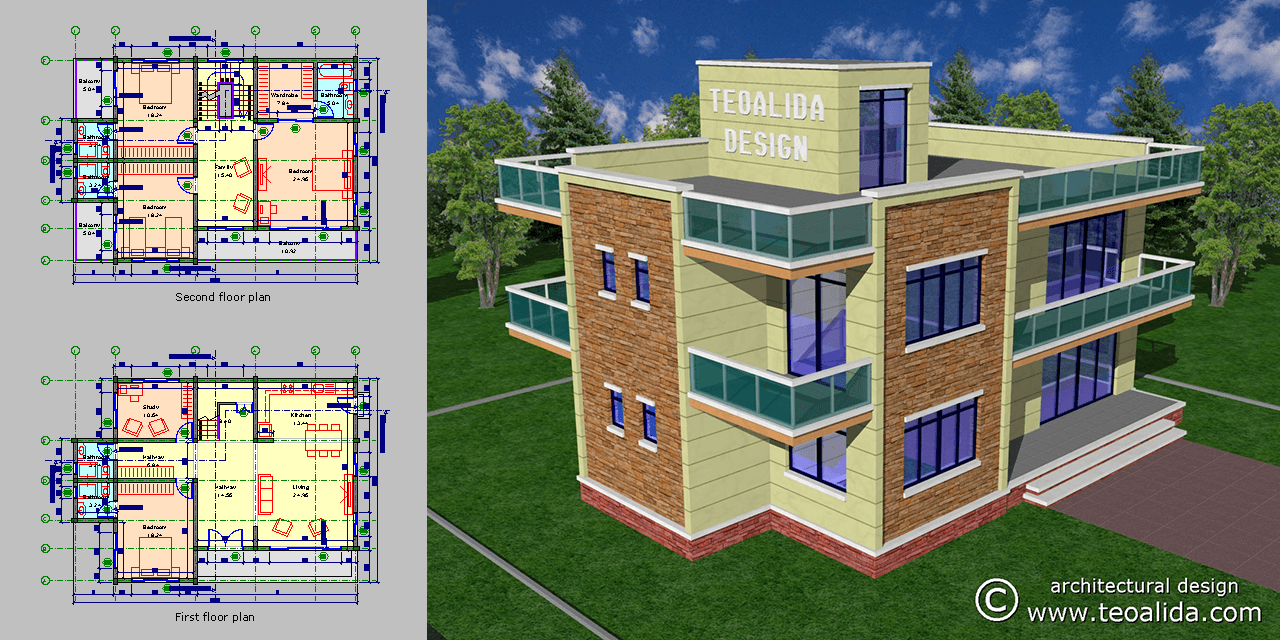
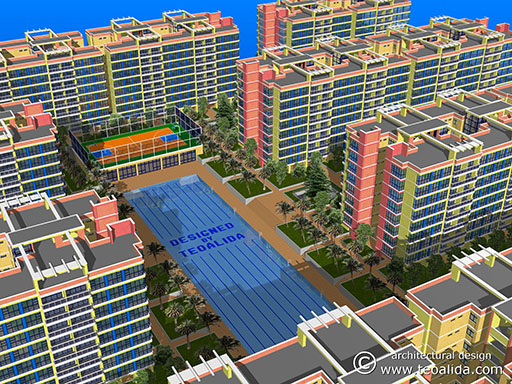
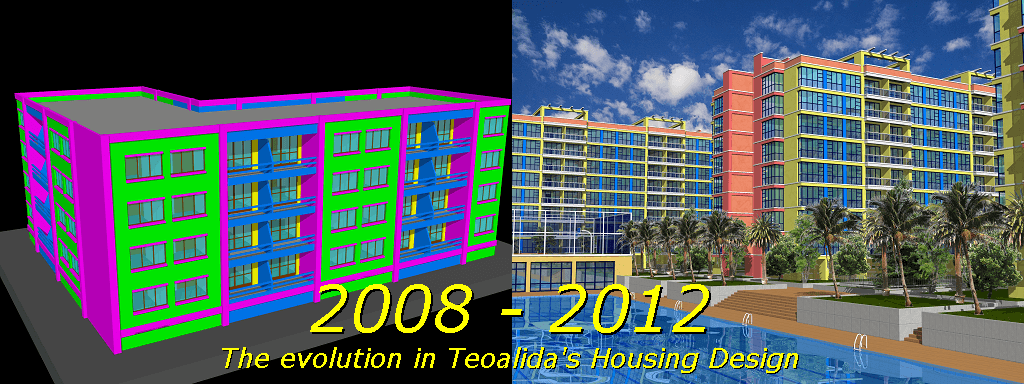
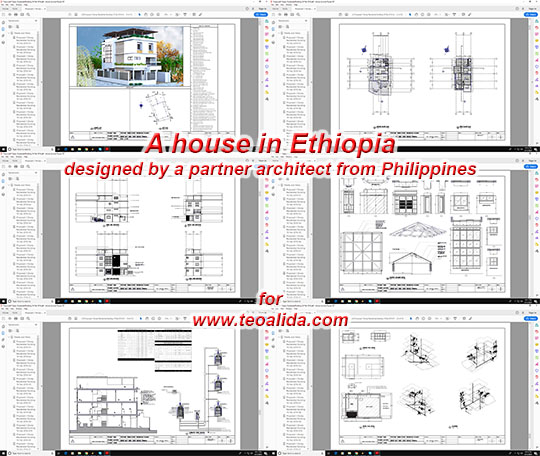
great!
next,please try making rules for your own new towns.
president?!! sorry but..you are either 14 or totally mental..lol
this is the sickest sht iv come across web in a long time…
Really? What is wrong if I design housing imagining that I am president… as long as I gained experience in this way, and now people appreciate my housing designs?
I beg to defer – you are not using your mental faculties to good effect, rips!
I think it brilliantly thought out!
nice design hope to be like you one day
thank you for all your works.. 🙂 thank u really..
Do u have any idea how touched i’m feeling right now. I know how does it feel when you’re taken for granted and treated as some random guy with avg. expertise despite the fact u do possess the passion for your work and can easily live up to their dreams. I dont know what to say but u managed to see a real life glimpse which is a brutal one, and did get through. So altogeter, i just hope best for you and your future. Keep your spirit up and don’t loose faith, afterall ” TOMORROW IS ANOTHER DAY”.
Hey dont mind the negative comment(s). They are just a bunch of sore lossers who dont know what to do in life. U are actually doing great! Greater than what u think 🙂 keep going